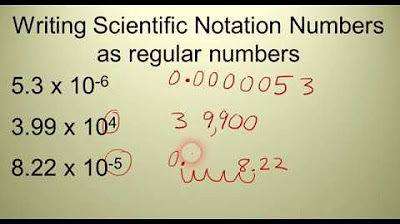Scientific Notation pt1
Summary
TLDRToday's lesson focuses on scientific notation, a method to express extremely large or small numbers concisely. The video explains the importance of Avagadro's number in chemistry and how scientific notation simplifies its representation. The key rules are highlighted: move the decimal point to have one non-zero digit to the left, and the exponent indicates the number of places moved. Examples demonstrate converting large and small numbers into scientific notation, emphasizing the coefficient and exponent. The video concludes with a preview of upcoming content on performing calculations using scientific notation.
Takeaways
- 🔢 Scientific notation is used to express very large or very small numbers in a compact form.
- 📏 The first rule of scientific notation is to move the decimal point so that there is only one non-zero digit to the left of the decimal.
- ✏️ Rule number two states that the exponent in scientific notation represents the number of places the decimal point has been moved.
- 🔑 The general form of a number in scientific notation is a coefficient multiplied by 10 raised to the power of an exponent.
- 🔄 For large numbers, the exponent is positive, and for small numbers, the exponent is negative.
- 🔎 Significant figures (sigfigs) can affect how you determine the coefficient in scientific notation.
- 🧮 Avogadro's number, a critical number in chemistry, is often expressed in scientific notation due to its large size.
- 📉 When dealing with small numbers, the decimal point is moved to the right, resulting in a negative exponent.
- 🔠 The coefficient in scientific notation is the non-zero digits left after adjusting the decimal point according to the first rule.
- 📚 In the next video, calculations using scientific notation will be discussed, often involving the use of a calculator.
Q & A
What is the purpose of scientific notation?
-Scientific notation is used to condense very large or very small decimal numbers into a more manageable form for calculations and representation.
What is Avogadro's number and why is it important in chemistry?
-Avogadro's number is the number of particles in a mole of a substance, which is approximately 6.02 × 10^23. It is crucial in chemistry as it helps in understanding the relationships between the macroscopic and microscopic properties of substances.
What is the first rule for expressing a number in scientific notation?
-The first rule is to move the decimal point so that there is only one non-zero digit to the left of the decimal point.
Can you explain the role of the exponent in scientific notation?
-The exponent in scientific notation indicates the number of places the decimal point has been moved. It is a power of 10 and is positive if the decimal point is moved to the left and negative if it is moved to the right.
What is meant by the coefficient in scientific notation?
-The coefficient in scientific notation is the non-zero digit(s) that remain after the decimal point has been moved according to the first rule. It is multiplied by 10 raised to the power of the exponent.
How do you determine if the exponent should be positive or negative when expressing a number in scientific notation?
-The exponent is positive if the original number is greater than 1 and the decimal point is moved to the left. It is negative if the original number is less than 1 and the decimal point is moved to the right.
What happens to the exponent in scientific notation when dealing with very small numbers?
-For very small numbers, the exponent in scientific notation is negative, reflecting the movement of the decimal point to the right to satisfy the first rule.
How can you convert a number from scientific notation back to its standard form?
-To convert from scientific notation to standard form, move the decimal point to the right for positive exponents and to the left for negative exponents by the number of places indicated by the exponent, filling in zeros where necessary.
Why is it important to know how to perform calculations with scientific notation even if a calculator can do it?
-Understanding calculations with scientific notation is important because there are instances where a calculator may not be available, or it is necessary to understand the underlying mathematics for educational or professional purposes.
What is the significance of significant figures in scientific notation?
-Significant figures are crucial in scientific notation as they determine the precision of the measurement. When expressing a number in scientific notation, only the significant figures are retained, and trailing zeros after the decimal point are not counted.
Outlines

This section is available to paid users only. Please upgrade to access this part.
Upgrade NowMindmap

This section is available to paid users only. Please upgrade to access this part.
Upgrade NowKeywords

This section is available to paid users only. Please upgrade to access this part.
Upgrade NowHighlights

This section is available to paid users only. Please upgrade to access this part.
Upgrade NowTranscripts

This section is available to paid users only. Please upgrade to access this part.
Upgrade Now5.0 / 5 (0 votes)





